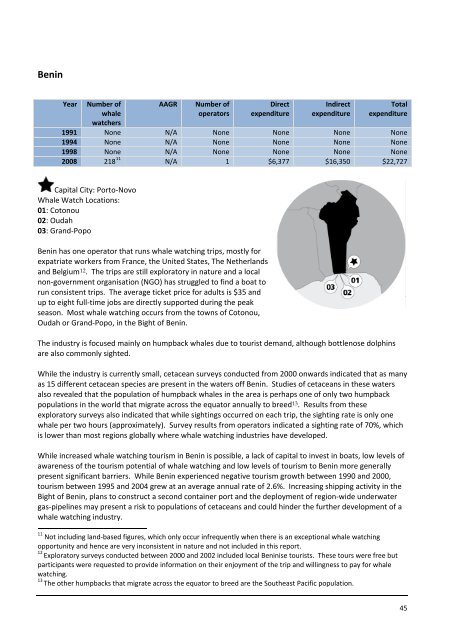Whale Watching Worldwide
Whale Watching Worldwide
Whale Watching Worldwide
Create successful ePaper yourself
Turn your PDF publications into a flip-book with our unique Google optimized e-Paper software.
Benin<br />
Year Number of<br />
whale<br />
watchers<br />
AAGR Number of<br />
operators<br />
Direct<br />
expenditure<br />
Indirect<br />
expenditure<br />
Total<br />
expenditure<br />
1991 None N/A None None None None<br />
1994 None N/A None None None None<br />
1998 None N/A None None None None<br />
2008 218 11 N/A 1 $6,377 $16,350 $22,727<br />
Capital City: Porto‐Novo<br />
<strong>Whale</strong> Watch Locations:<br />
01: Cotonou<br />
02: Oudah<br />
03: Grand‐Popo<br />
Benin has one operator that runs whale watching trips, mostly for<br />
expatriate workers from France, the United States, The Netherlands<br />
and Belgium 12. The trips are still exploratory in nature and a local<br />
non‐government organisation (NGO) has struggled to find a boat to<br />
run consistent trips. The average ticket price for adults is $35 and<br />
up to eight full‐time jobs are directly supported during the peak<br />
season. Most whale watching occurs from the towns of Cotonou,<br />
Oudah or Grand‐Popo, in the Bight of Benin.<br />
The industry is focused mainly on humpback whales due to tourist demand, although bottlenose dolphins<br />
are also commonly sighted.<br />
While the industry is currently small, cetacean surveys conducted from 2000 onwards indicated that as many<br />
as 15 different cetacean species are present in the waters off Benin. Studies of cetaceans in these waters<br />
also revealed that the population of humpback whales in the area is perhaps one of only two humpback<br />
populations in the world that migrate across the equator annually to breed 13. Results from these<br />
exploratory surveys also indicated that while sightings occurred on each trip, the sighting rate is only one<br />
whale per two hours (approximately). Survey results from operators indicated a sighting rate of 70%, which<br />
is lower than most regions globally where whale watching industries have developed.<br />
While increased whale watching tourism in Benin is possible, a lack of capital to invest in boats, low levels of<br />
awareness of the tourism potential of whale watching and low levels of tourism to Benin more generally<br />
present significant barriers. While Benin experienced negative tourism growth between 1990 and 2000,<br />
tourism between 1995 and 2004 grew at an average annual rate of 2.6%. Increasing shipping activity in the<br />
Bight of Benin, plans to construct a second container port and the deployment of region‐wide underwater<br />
gas‐pipelines may present a risk to populations of cetaceans and could hinder the further development of a<br />
whale watching industry.<br />
11 Not including land‐based figures, which only occur infrequently when there is an exceptional whale watching<br />
opportunity and hence are very inconsistent in nature and not included in this report.<br />
12 Exploratory surveys conducted between 2000 and 2002 included local Beninise tourists. These tours were free but<br />
participants were requested to provide information on their enjoyment of the trip and willingness to pay for whale<br />
watching.<br />
13 The other humpbacks that migrate across the equator to breed are the Southeast Pacific population.<br />
45

















